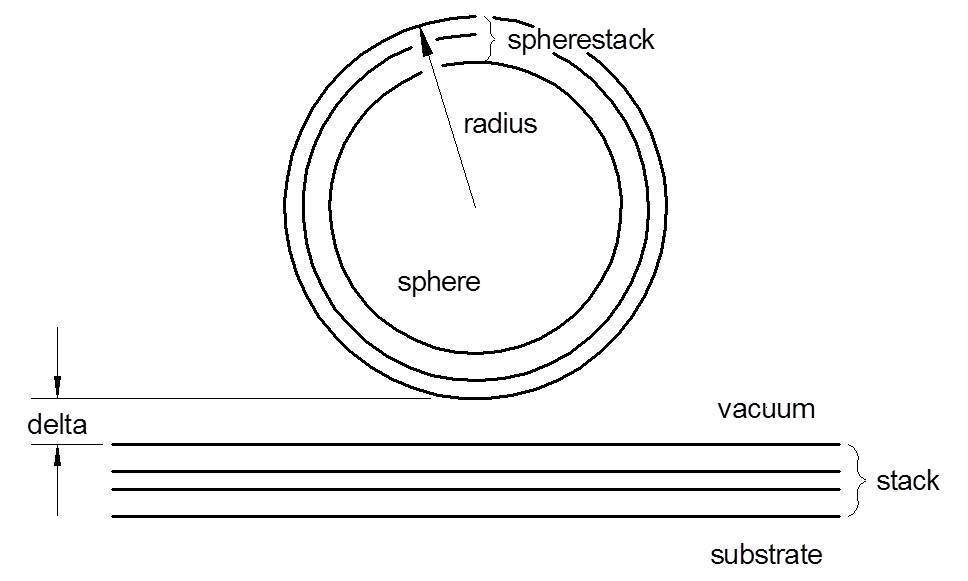class Bobbert_Vlieger_BRDF_Model
The Bobbert_Vleiger_BRDF_Model implements the theory
of Bobbert and Vlieger for the scattering by a sphere on a
substrate. The theory applies to a sphere of total radius
radius having any number of coatings, a distance
delta above a surface, which can also have any number of coatings. The sphere
must lie entirely above the substrate film stack.
The theory is exact, although care must be
taken to choose appropriate operating parameters, and
convergence should always be checked.

Parameters:
| Parameter | Data Type | Description | Default |
|---|---|---|---|
| lambda | double | Wavelength of the light
in vacuum [µm]. (Inherited from BRDF_Model.) |
0.532 |
| type | int |
Indicates whether the light is incident from above the
substrate or from within the substrate and whether the
scattering is evaluated in reflection or transmission.
The choices are: 0 : Light is incident from the above the substrate, and scattering is evaluated in reflection. 1 : Light is incident from the above the substrate, and scattering is evaluated in transmission. 2 : Light is incident from the within the substrate, and scattering is evaluated in reflection. 3 : Light is incident from the within the substrate, and scattering is evaluated in transmission. For 1, 2, and 3, the substrate must be non-absorbing. Bobbert_Vlieger_BRDF_Model supports all four types. (Inherited from BRDF_Model). |
0 |
| substrate | dielectric_function | The
optical constants of the substrate, expressed as a
complex number (n,k) or, optionally, as a function of
wavelength. (Inherited from BRDF_Model.) |
(4.05,0.05) |
| density | double | The
surface number density of local scatterers
[µm-2]. (Inherited from Local_BRDF_Model.) |
1 |
| sphere | dielectric_function | The optical constants of the particle, expressed as a complex number (n,k) or, optionally, as a function of wavelength. | (1.59,0) |
| radius | double | The total radius of the spherical particle [µm]. This radius includes the thickness of any coatings. | 0.05 |
| spherecoat | StackModel_Ptr | Description of any stack of coatings on the particle. | No_StackModel |
| stack | StackModel_Ptr | Description of any stack of films deposited on the substrate. | No_StackModel |
| delta | double | The distance between the particle and the substrate [µm]. This value is zero when the particle is touching the substrate. It cannot be less than zero. | 0 |
| lmax | int | Maximum spherical harmonic order used in the calculation. Setting this value to 0 sends a request to use the value appropriate for the free-space particle, as suggested by Bohren and Huffman. For negative values of lmax, the lmax appropriate for the free-space particle is increased by the absolute value of lmax. For an accurate solution, convergence should be checked by varying this parameter. | 0 |
| order | int | The perturbative order for the solution. For the exact solution, the order should be set to -1. When order is set to 0, the model reproduces the Double_Interaction_BRDF_Model with a MieScatterer. When order is set to 1 or higher, matrix inversion is performed by successive approximation. This parameter is included in the model, but should normally be set to -1 for the exact solution. | -1 |
| Norm_Inc_Approx | int | A flag indicating whether or not to use the Normal Incidence Approximation in the calculation. This approximation assumes that the reflection coefficients of the substrate are constant and given by their normal incidence values. This approximation is valid for a perfectly reflecting metallic substrate, or if the distance of the particle from the surface is large. This approximation is included for pedagogical reasons, and the flag should be set to 0 for an accurate solution. See the reference by Videen for details. | 0 |
| improve | int | The number of iterative improvement iterations. For lmax much larger than that needed for the free-space Mie scattering solution, the matrix inversion accumulates some significant errors that propagate to the final scattering solution. Setting this value to something other than 0 increases the computation time needed for each different incident angle but improves the solution stability significantly. A value of 2 or 3 has been found to be satisfactory under all tested conditions. | 3 |
See also:
SCATMECH Home, Conventions, Local_BRDF_Model, Subsurface_Bobbert_Vlieger_BRDF_Model
P.A. Bobbert and J. Vlieger, "Light scattering by a sphere on a substrate," Physica 137A, 209-242 (1986).
P.A. Bobbert, J. Vlieger, and R. Greef, "Light reflection from a substrate sparsley seeded with spheres - Comparison with an ellipsometric experiment," Physica 137A, 243-257 (1986).
J.H. Kim, S.H. Ehrman, G.W. Mulholland, and T.A. Germer, "Polarized light scattering from metallic particles on silicon wafers," Proc. SPIE 4449, 281-290 (2001).
G. Videen, "Light scattering from a sphere on or near a surface," J. Opt. Soc. Am. A 8, 483-489 (1991).
Include file:
#include "bobvlieg.h"
Source code:
bobvlieg1.cpp bobvlieg2.cpp bobvlieg3.cpp
Definition of public elements:
class Bobbert_Vlieger_BRDF_Model : public Local_BRDF_Model { complex<double> Epp(double thetai,double thetas,double phis); complex<double> Eps(double thetai,double thetas,double phis); complex<double> Esp(double thetai,double thetas,double phis); complex<double> Ess(double thetai,double thetas,double phis); MuellerMatrix Specular(double theta); };
complex<double> Epp(double thetai,double
thetas,double phis)
complex<double> Eps(double
thetai,double thetas,double phis)
complex<double> Esp(double
thetai,double thetas,double phis)
complex<double> Ess(double
thetai,double thetas,double phis)
Routines which return the elements of the Jones matrix for scattering from a sphere on a surface. These elements are the same as those calculated by jonesDSC, and these routines provide a means for obtaining each term individually.
MuellerMatrix Specular(double theta)
This function returns the Mueller matrix specular reflectance (for type==0 or type==2 or the regular transmittance (for type==1 or type==3) for an incident angle of theta (in radians). The result is derived from the optical theorem and is only valid when density is suffiently low that multiple scattering between spheres can be neglected.Example:
Bobbert_Vlieger_BRDF_Model model; model.set_type(0); MuellerMatrix R = Specular(theta);
For More Information
SCATMECH Technical Information and Questions
Sensor Science Division Home Page
Sensor Science Division Inquiries
Website Comments
Current SCATMECH version: 7.22 (April 2021)